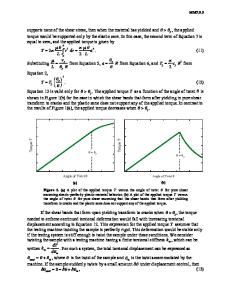The Role of Disorder and the Elastic Robustness of Bulk Metallic Glasses
- PDF / 471,075 Bytes
- 6 Pages / 595 x 842 pts (A4) Page_size
- 53 Downloads / 221 Views
The Role of Disorder and the Elastic Robustness of Bulk Metallic Glasses
P. M. Derlet1 and R. Maaß2 1 2
Condensed Matter Theory Group, Paul Scherrer Institut, CH-5232 Villigen PSI, Switzerland California Institute of Technology, Division of Engineering and Applied Sciences, USA
ABSTRACT Despite significant atomic-scale heterogeneity, bulk metallic glasses well below their glass transition temperature exhibit a surprisingly robust elastic regime and a sharp elastic-to-plastic transition with a yield stress that depends approximately linearly on temperature. The present work attempts to understand these features within the framework of thermally activated plasticity. The presented statistical thermal activation model, in which the number of available structural transformations scales exponentially with system size, results in two distinct temperature regimes of deformation. At temperatures close to the glass transition temperature thermally activated Newtonian plastic flow emerges, whilst at lower temperatures the deformation properties fundamentally change due to the eventual kinetic freezing of the available structural transformations. In this regime, a linear temperature dependence emerges for the stress which characterises the elastic to plastic transition. For both regimes the transition to macroscopic plastic flow corresponds to a transition from a barrier energy dominated to a barrier entropy dominated statistics. The work concludes by discussing the possible influence that kinetic freezing might have on the low temperature heterogeneous and high temperature homogeneous plasticity of bulk metallic glasses. INTRODUCTION The deformation properties of bulk metallic glasses (BMGs) are broadly characterised by two temperature regimes [1]. In the high temperature regime, close to the glass transition temperature, BMGs deform homogeneously with the strain rate properties being reasonably well understood by thermally activated Newtonian plastic flow. At lower temperatures, plasticity becomes heterogeneous leading to low ductility in tension and shear banding in compression. In this regime of temperatures both athermal [2] and thermal [3] theories of plasticity have been proposed. Experimentally the yield stress has a decreasing, approximately linear, dependence on stress that is insensitive to material type when normalised with respect to a representative shear modulus and the glass transition temperature [3]. As the temperature approaches (and depending to the strain rate) passes, Tg , there is also an abrupt drop in the yield stress as the plasticity transits to the high temperature homogeneous deformation mode [4]. The present work outlines an attempt to understand the entire temperature range of plasticity via the thermal activation hypothesis and a distribution of relevant energy barriers. As with viscosity, a characteristic time scale of irreversible structural transformation activity is considered, τp , where below the glass transition temperature its inverse is seen as a plastic rate. Since in the low temper
Data Loading...











